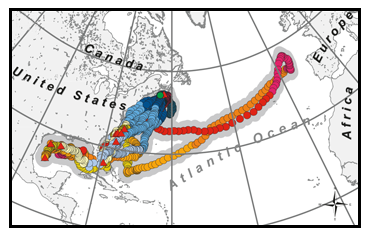RESEARCH
SEE THE OCEAN THROUGH THE LENS OF SCIENCE.
Since the eighties, the International Commission for the Conservation of Atlantic Tunas (ICCAT) has managed Atlantic bluefin tuna according to the “two-stock” theory. According to this theory, “eastern” and “western” stocks are separated by an arbitrary line at 45°W longitude. The foundation of this theory is based on certain key assumptions about the movements and biology of Atlantic bluefin tuna on either side of the line.
It should be noted that one of these assumptions has recently been officially overturned at the international management level. Until recently it was said that fish on either side of the 45° line stayed on their side of the line—and that there was no appreciable ‘mixing’—despite many decades of evidence proving transatlantic movements of Atlantic bluefin tuna. Although this key tenet of the two-stock theory is no longer, its impact on management remains.

“Transatlantic movements of Atlantic bluefin tuna (Thunnus thynnus) have been well-documented by classical mark and recapture techniques since the 1950s (NRC 1994).”
Interannual Variation in Large-scale Movements of Atlantic Bluefin Tuna Determined From Pop-up Archival Satellite tags
OUR PRIMARY RESEARCH PRIORITIES
At The Bluefin Collaborative, we will strive to address all key unresolved questions pertaining to Atlantic bluefin tuna. But here is where we will start.
OUR PRIMARY RESEARCH PRIORITIES
At The Bluefin Collaborative, we will strive to address all key unresolved questions pertaining to Atlantic bluefin tuna. But here is where we will start.
REPRODUCTIVE BIOLOGY
As it is with all fish species, age of maturity is a critical reference point for the assessment of Atlantic bluefin tuna as it is used to determine productivity. Under the current management paradigm, it is assumed that Atlantic bluefin tuna spawn at different ages on either side of the Atlantic. Specifically, it is said that the “western” fish mature at 8-12 years of age whereas the “eastern” fish mature at 3-5 years of age—a substantial difference. This belief that the maturity schedules on either side may differ is one of the pillars of the two-stock theory. But is this assumption correct?
“Our study suggests that the maturity ogives for eastern and western stocks may also be similar and the current assumption of sexual maturity for western ABFT is incorrect…”
Sexual Maturity in Western Atlantic Bluefin Tuna
“There is a major debate as to the extent of similarity/disparity in reproductive traits between eastern and western ABFT stocks… similarities have been found in major reproductive aspects suggesting that discrepancies between stocks may not be as broad as often assumed.”
ABFT Reproductive Workshop Report, Madrid, Spain, 2019
“The present review of classical and recent literature suggests that ABFT have more complex reproductive behavior than previously considered…”
Review of Sexual Maturity in Atlantic Bluefin Tuna
POPULATION STRUCTURE
The science guiding fisheries regulations requires a thorough understanding of Atlantic bluefin tuna migrations through their lifetime—including when and where they spawn. The very foundation of the current scientific narrative is based on the idea that there are only two spawning areas—the Mediterranean Sea and the Gulf of Mexico—and two related stocks that exhibit spawning site fidelity. Is this simple understanding correct?
“Our cumulative tagging results support scenarios proposed by Goldstein et al. (2007) and Mather et al. (1974) that ABFT have asynchronous reproductive schedules and may spawn in the warm waters (>24 8C) of the Gulf Stream or Caribbean Sea. Thus, an alternative hypothesis could be that ABFT in the western Atlantic have spatially or temporally stratified spawning according to size (Goldstein et al. 2007), as is the case in the Mediterranean Sea (Heinisch et al. 2008) and with Pacific bluefin tuna (Thunnus orientalis) (Itoh 2006).”
Complex Migration Routes of Atlantic Bluefin Tuna, Questions Current Population Structure Paradigm
“We present unequivocal evidence that Atlantic bluefin tuna spawn in the Slope Sea, counter to the current assumption that the Gulf of Mexico and Mediterranean Sea are the exclusive spawning grounds.”
Discovery of a Spawning Ground Reveals Diverse Migration Strategies in Atlantic Bluefin Tuna
“Overall, our results provide supporting evidence that the Slope Sea is a major spawning ground that is likely to be important for population dynamics.”
Support for the Slope Sea as a Major Spawning Ground for Atlantic Bluefin Tuna
ABUNDANCE
If you cannot count them, you cannot manage them properly. The lack of effective indices of abundance for Atlantic bluefin tuna is one of the primary reasons that recent stock assessments have not met the standards needed to be used to give management advice. To be clear, few tasks are harder than accurately counting or estimating the numbers of such a mobile and complex species as Atlantic bluefin tuna. Nevertheless, the need for accurate counting and/or estimation is just as important as understanding bluefin biology and behavior. In the absence of tools that allow for direct assessment, too much emphasis is placed on landings history, which is not science, and CPUE-based indices, which are notoriously unreliable. Without trustworthy indices of either absolute or relative abundance, how can scientists set quotas that are based on reality?
“The VPA and Stock Synthesis are not reliable enough for providing management advice.”
2021 Western Atlantic Assessment External Review by Mark Maunder
“A problem with CPUE-derived estimates of stock biomass, however, is that they are affected by changes in fishing effort, technology, fish density and the marketplace…”
The Feasibility of Direct Photographic Assessment of Giant Bluefin Tuna, Thunnus thynnus, in New England Waters
SECONDARY RESEARCH PRIORITIES
ENVIRONMENTAL FACTORS AND RELATED IMPACTS
Atlantic bluefin tuna are impacted greatly by various environmental factors. For example, forage quality and availability directly influence movements and productivity. It is critical to have as full an understanding as possible about how the environment drives bluefin behavior and life history in order to manage effectively.
SITING OF OFFSHORE WIND FARMS
Wind farms have the potential to drastically impact the areas they are built in. For example, wind farms can change wind patterns and the currents they help drive. As such, the siting of wind farms has potential to cause harm to Atlantic bluefin tuna habitat. Any siting decisions must involve full participation by experts on Atlantic bluefin tuna. Furthermore, more science must be produced to help guide potential development.
SECONDARY RESEARCH PRIORITIES
ENVIRONMENTAL FACTORS AND RELATED IMPACTS
Atlantic bluefin tuna are impacted greatly by various environmental factors. For example, forage quality and availability directly influence movements and productivity. It is critical to have as full an understanding as possible about how the environment drives bluefin behavior and life history in order to manage effectively.
SITING OF OFFSHORE WIND FARMS
Wind farms have the potential to drastically impact the areas they are built in. For example, wind farms can change wind patterns and the currents they help drive. As such, the siting of wind farms has potential to cause harm to Atlantic bluefin tuna habitat. Any siting decisions must involve full participation by experts on Atlantic bluefin tuna. Furthermore, more science must be produced to help guide potential development.
OUR SOLUTIONS
Unfortunately, no silver bullet exists. There are no shortcuts. We will take an integrated approach that brings together a wide range of tools in order to succeed.
Histology, Endocrine Analysis, and Morphometrics
Analysis of the reproductive system and the body condition of sampled Atlantic bluefin tuna will help us answer questions about the age of maturity and location of spawning.
Genetics
Looking closely at the DNA of Atlantic bluefin tuna can help us answer questions about population structure, abundance, and other important biological factors. We have already begun a Tissue Sampling Pilot Project stretching from Canada to the Carolinas and are in the process of expanding this project for Year 2. We are also accepting research proposals to analyze this genetic data with both new and already-developed tools.
Tagging
One of the oldest tools in the kit is still important as it helps us understand movements of these fish. The Bluefin Collaborative will support and promote tagging and work with independent scientists to improve and modernize it.
Increased Biological Sampling
The Bluefin Collaborative will relentlessly increase sampling on and off the water to bolster all aspects of our efforts.
A NOTE ON THE MANAGEMENT STRATEGY EVALUATION
At the end of 2022, after much time and effort, ICCAT approved a Management Strategy Evaluation, or MSE, for Atlantic bluefin tuna. At its core, the MSE is a method for dealing with uncertainties present in the understanding of these fish. Some believe that the MSE solves many problems. But it cannot be ignored that the MSE is using the very same data and assumptions that led to prior assessments being deemed unfit for use by managers. In fact, the MSE places even more emphasis on these failed indicators than ever before. As such, it has never been more important to address the many remaining uncertainties present regarding Atlantic bluefin tuna.

The Bluefin Collaborative is a nonprofit, tax-exempt charitable organization (tax identification number 87-3332779) under section 501(c)(3) of the U.S. Internal Revenue Code. Donations are tax-deductible to the full extent allowable under law.
TBC Policy on Indirect Costs: It is the intent of The Bluefin Collaborative to fund only the direct costs of research projects performed by third parties. Therefore, as a policy, The Bluefin Collaborative does not fund indirect costs.


